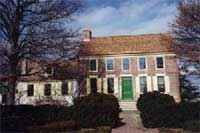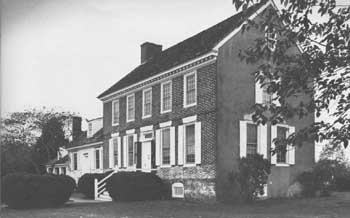







Survey of
Historic Sites and Buildings
 |
DICKINSON (John) MANSION Delaware |
 John Dickinson Mansion |
| ||
This early Georgian residence, sometimes called Kingston-upon-Hull, was the home of John Dickinson during his boyhood and most of the period from late 1776, when he moved his family there because the British threatened Philadelphia, until 1782. During these years, he suffered temporary political disfavor because of his opposition to the Declaration of Independence.
The mansion was erected in 1739-40 by his father, Judge Samuel Dickinson, on a 1,300-acre plantation he had purchased. He moved his family there from Crosiadore estate in Maryland when young Dickinson was about 8 years old. He lived in the new home for about a decade, and then at the age of 18 departed to study law at Philadelphia, though in later years he again resided in it.
The original hip-roofed, five-bay structure rose three full stories over a high basement. To conserve heat, the north side had only three windows. Later, two stepped-down wings were erected on the west side. Both featured shed-type dormers and were 1-1/2 stories in height. The first was added in 1752; and the second, a smaller one, fronted by a brick-columned porch, 2 years later.
In 1804-6, following a fire that ravaged the mansion, John Dickinson rebuilt it. He reduced the main house to its present two stories and replaced the hip roof with the existing gable type. Because of the intended use of the building by tenants, the fine interior woodwork and paneling were replaced with simpler materials.
 |
| Dickinson Mansion. (National Park Service (Boucher, 1975).) |
The mansion, which faces to the south, is in excellent condition. Parts of it are constructed in Flemish, English, and common-bonded brick with black, glazed headers. The east wall has been plastered over, and portions of the walls of the three units have been whitewashed. The unusually tall first-floor windows of the main house reflect the original three-story height. Most of the windows are shuttered and topped by flat arches. The cornice is dentiled.
To the east of the wide center hall is the parlor; to the west, two smaller rooms, each equipped with an angle fireplace. The upstairs room pattern in the main house is basically the same. The larger wing contains a dining room on the first floor and a bedroom above; the smaller, a kitchen under what were once quarters for household slaves. The cellar under the main house and adjacent wing originally consisted of a large storage room, wine cellar, and scullery-kitchen.
In 1952 the State of Delaware, aided by the National Society of Colonial Dames of America, acquired the house and grounds. Before the decade ended, using State funds and private gifts, the mansion was restored to its 1806 appearance and landscaped. Some of the furnishings were once owned by the Dickinson family. The Delaware State Museum administers the site.
 |
 |
http://www.cr.nps.gov/history/online_books/constitution/site3.htm
Last Updated: 29-Jul-2004